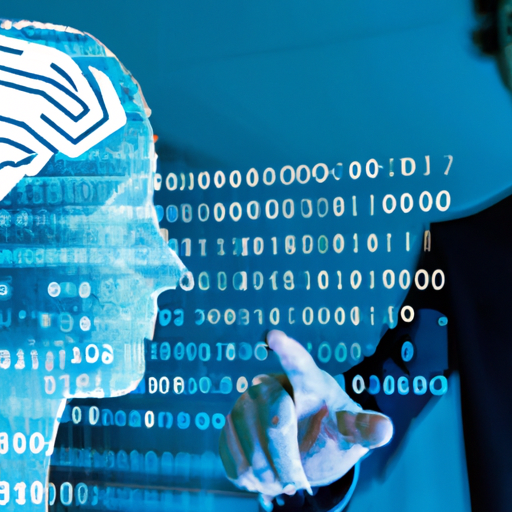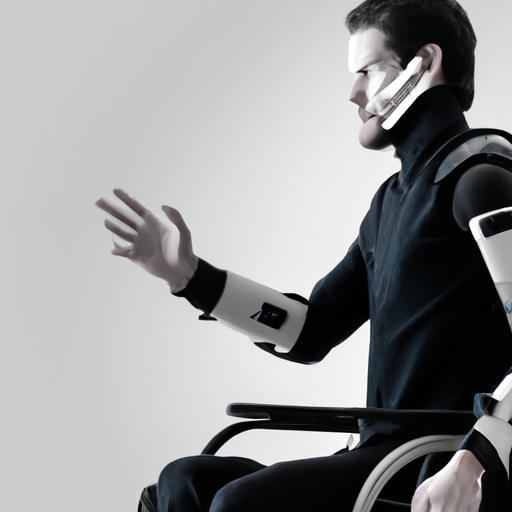
The Revolution of Accessibility: How AI is Changing the Lives of People with Disabilities
September 2, 2023
8 Ways to building collaborative Teams: The Key to successful execution
September 10, 2023Unleashing the Potential: AI’s Role in Revolutionizing Inclusion for People with Disabilities
Unleashing the potential of artificial intelligence (AI) is revolutionizing accessibility and inclusion for people with disabilities. With advanced AI technology, various types of disabilities, such as visual impairment, hearing impairment, and reduced mobility, can now be better addressed and supported. AI plays a crucial role in removing accessibility barriers through image recognition, facial recognition, lip-reading recognition, text summarization, real-time captioning or translations, and much more. From AI apps and smartphones to navigation systems and self-driving cars, people with disabilities can now communicate, navigate, and live more independently, improving their overall quality of life. Additionally, AI technology also enhances web accessibility and provides virtual assistants that assist with daily tasks, making homes more inclusive and accommodating for all. The potential is vast, and AI is paving the way for a more inclusive society for people with disabilities.

AI’s Role in Revolutionizing Inclusion for People with Disabilities
Artificial intelligence (AI) is playing a groundbreaking role in revolutionizing accessibility and inclusion for people with disabilities. By leveraging advanced technologies, AI is removing barriers and creating opportunities for individuals with various disabilities. From visual impairment to hearing impairment, reduced mobility to communication and connectivity, AI is transforming lives and enabling individuals to thrive in a more inclusive society.
Visual Impairment
Image Recognition
AI technology has made significant advancements in image recognition, enabling individuals with visual impairments to interact with the world around them. Through the use of AI-powered cameras and algorithms, images can be described in detail, allowing individuals to understand and visualize their surroundings.
Facial Recognition
Facial recognition technology can also be used to assist individuals with visual impairments. By recognizing and describing people’s facial features, emotions, and actions, AI can enhance social interactions and help individuals with visual impairments recognize familiar faces.
Text Summarization
For individuals with visual impairments, reading large amounts of text can be a daunting task. AI algorithms can analyze text and summarize it in a more concise and accessible format, making it easier for individuals with visual impairments to comprehend and navigate through vast amounts of information.
Screen Readers
Screen readers are an invaluable tool for individuals with visual impairments. These AI-powered software applications can interpret and read aloud text displayed on a screen, allowing individuals to access and navigate through digital content, including websites, documents, and emails.
Virtual Assistants
Virtual assistants, such as Siri, Google Assistant, and Alexa, are becoming increasingly accessible to individuals with visual impairments. By utilizing voice recognition and AI capabilities, these virtual assistants can perform tasks and provide information, making daily activities more manageable.

Hearing Impairment
Real-Time Captioning and Translation
AI technology has paved the way for real-time captioning and translation services, benefiting individuals with hearing impairments. By leveraging automatic speech recognition and natural language processing, AI algorithms can transcribe spoken words into text in real-time, making communication more accessible and inclusive.
Transcription Apps
Transcription apps powered by AI can convert audio content, such as lectures, meetings, and interviews, into written text. This enables individuals with hearing impairments to review and understand spoken information, contributing to their participation in various settings.
Voice Control
Voice control technology, enabled by AI, allows individuals with hearing impairments to interact with devices and applications using voice commands. This technology enhances accessibility by eliminating the need for physical interaction with devices and providing a more intuitive and independent user experience.
Reduced Mobility
Wheelchair-Accessible Routes
AI-powered navigation apps and platforms now offer wheelchair-accessible routes, making it easier for individuals with reduced mobility to navigate through urban environments. By providing information on accessible pathways, ramps, and elevators, these apps empower individuals with reduced mobility to move around with greater ease and independence.
Accessible Places Information
In addition to wheelchair-accessible routes, AI-enabled navigation apps provide detailed information about accessible places, such as restaurants, stores, and public facilities. This information includes accessibility features like wheelchair ramps, accessible washrooms, and assistance services, enabling individuals with reduced mobility to plan their outings and visits more confidently.
Self-Driving Cars
Self-driving cars have the potential to revolutionize mobility for individuals with disabilities, including those with reduced mobility. Through AI-powered technologies, these vehicles can navigate roads autonomously, improving independence, convenience, and overall accessibility in transportation.

Communication and Connectivity
AI-powered Communication Apps
AI technology has facilitated the development of communication apps that assist individuals with disabilities in expressing themselves and staying connected. These apps can translate sign language, interpret facial expressions, and provide speech-to-text capabilities, fostering better communication and inclusivity.
Virtual Assistants for Daily Tasks
Virtual assistants, like Siri and Alexa, have become valuable companions for individuals with disabilities, helping them with daily tasks. These AI-powered assistants can set reminders, make phone calls, manage schedules, and even control smart home devices, allowing individuals with disabilities to navigate their daily lives more independently.
Improved Quality of Life
By enabling individuals with disabilities to communicate effectively and access information, AI technology has contributed to an overall improved quality of life. From facilitating social interactions to enhancing productivity and access to education, AI has opened doors to opportunities that were previously limited or inaccessible.
Web Accessibility
Optimizing Website Design
AI technology has played a crucial role in improving web accessibility for individuals with disabilities. Through AI algorithms, websites can be designed with accessibility features in mind, such as scalable text, color contrast, and navigational aids. This ensures that individuals with visual impairments or other disabilities can access and navigate websites effectively.
Adaptive Technologies
AI-powered adaptive technologies, such as screen readers and magnification tools, allow individuals with disabilities to interact with websites more efficiently. By dynamically adjusting the display and readability of web content, these technologies enhance accessibility and usability for individuals with visual impairments or other disabilities.
Assistive Technologies
AI-powered assistive technologies, such as voice recognition software, help individuals with disabilities interact with websites using voice commands. This eliminates the need for traditional input methods, such as keyboards or mice, and provides a more inclusive and accessible web browsing experience.

Navigation Apps
Location Tracking and Guidance
AI-powered navigation apps utilize advanced location tracking and mapping technologies to provide individuals with disabilities accurate and real-time guidance. By offering step-by-step directions and updates on travel times, these apps enable individuals to navigate their surroundings independently and confidently.
Accessible Public Transportation Information
Navigation apps equipped with AI technology provide detailed information about accessible public transportation options, including wheelchair-accessible routes, accessible stations, and available assistance services. This empowers individuals with disabilities to plan their trips efficiently, ensuring a more seamless and inclusive travel experience.
Detailed Accessibility Feedback
To further improve accessibility, some navigation apps allow users to provide feedback on the accessibility of specific locations. This helps create a community-driven database of accessibility information, benefiting individuals with disabilities by providing valuable insights and recommendations.
Self-Driving Cars
Independence and Convenience
Self-driving cars present a transformative solution for individuals with disabilities, offering increased independence and convenience in transportation. By leveraging AI technology, these vehicles can navigate roads, adapt to traffic conditions, and transport individuals with disabilities safely and efficiently.
Safety Features
Self-driving cars are equipped with advanced safety features, such as collision detection and emergency braking systems, that can significantly reduce the risk of accidents. These technologies provide a heightened sense of security for individuals with disabilities, enabling them to travel more confidently and without physical driving constraints.
Mobility Challenges Addressed
For individuals with disabilities, mobility challenges are often a significant barrier to independence and inclusion. Self-driving cars, with their ability to provide convenient and accessible transportation, address these challenges and offer a promising solution for individuals with disabilities to access opportunities and participate in society.

Accessibility at Home
Virtual Assistants for Daily Tasks
Virtual assistants, such as Siri, Google Assistant, and Alexa, have found their way into countless homes, including those of individuals with disabilities. These AI-powered assistants can perform a wide array of tasks, such as turning lights on and off, adjusting thermostat settings, and controlling entertainment systems, making daily activities more accessible and manageable.
Smart Home Integration
AI technology has facilitated the integration of smart home devices and assistive technologies, creating a more accessible home environment for individuals with disabilities. By connecting various devices and appliances, individuals can control their surroundings using voice commands or through smartphone apps, promoting independence and convenience.
Assistive Devices and Applications
AI-powered assistive devices and applications have emerged as essential tools for individuals with disabilities at home. From smart glasses with object recognition capabilities to apps that assist with medication management and personal care, these technologies empower individuals to live more independently and comfortably within their own homes.
Conclusion
The impact of AI on inclusion for people with disabilities cannot be overstated. By leveraging advanced technologies, AI is breaking down barriers and creating opportunities in various aspects of life, including communication, mobility, and accessibility. Continuous innovation and collaboration between AI developers, researchers, and individuals with disabilities are paving the way for a more inclusive and promising future. With AI’s transformative potential, the goal of achieving full accessibility and inclusion for all is closer than ever before.


